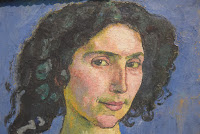(...)
Gaining access to the Wallraf Richartz Museum's collections was like the certainty of having a marvellous afternoon surrounded by Art. Because of the huge housing collection we opted to start by the Impressionist on one of the upper floors. We unexpectedely came across the Claude Monet's forged painting "On the banks of the Seine by Port Villez" exhibited in one of the floor corridors.
We then proceeded to admire some of the best exhibited paintings, many of which I had already "seen" in books, though there were quite a few, whose artists I had never heard of.
Finished? by Lovis Corinth (1858-1925)
Corinth is said to show the dead body of the crucified Christ with such a bold directness that comes across as threatening. His arms are spread as if to embrace and the hands claw-like are stiff in death to which the physicallity of the scene has been added by means of the way Mary Magdalene throws herself onto Him, as well as the gestures and facial expressions of the other protagonists are displayed.
Asgardstrand by Edvard Munch (1863-1944) above and Melancholy below.


Munch is said not to have been particularly interested in portraying the outside world. His works always aimed atconveying mental processes and inner states. His use of colour is also said to have been inspired by this idea, this being the reason as to why htey seem to be less attunned to reality and more the evoking atmospheres. The girls seem to be waiting for their fate, but it does not bode well for them.
Portrait of Giulia Leonard by Ferdinand Hodler (1853-1918)
It is said Hodler met the Italian singer Giulia Leonard in a café in Geneva and was immediately taken by her austere beauty and Mediterranean temperament. He is then said to have engaged her as a model and thus captured her features in numerous studies.Hodler's emotional approach is reflected in the strong colours and expressive application of paint.

Bathers by Max Klinger (1857-1920)
The bleaching ground by Max Liebermann (1847-1935)
Although Liebermann knew the French Impressionists he is said to have initially loathed them. He believed that the correct way to render atmospheres was by shading and not colour contrasts. The Bleaching Ground is one of his masterpieces.
Walchensee Panorama by Lovis Corinth (1858-1925).
Corinth is known as the "Fauve" among the German Impressionists. In his late landscapes he seems to have given free reign to a gestural approach to applying the paint. Even though he had become handicapped by a stroke, witnesses have forever affirmed that his hand was quite steady and remained so when he picked up the brush.
Coast at Trouville by Eugene Boudin (1824-1898)
Bridge at Hampton Court by Alfred Sisley (1839-1899)
Taking leisure pursuits as the subject of painting was something the Impressionists discovered. Although Sisley is not one of the main forces behind Impressionsim in his best paintings he seems to have captured the lively and summery atmosphere with great success.
L'Hermitage by Pontoise by Camille Pissarro (1830-1903)
Cottage in Nuenen by Vincent van Gogh (1853-1890)
This small cottage is regarded as the home of the De Groot family, later made famous as the "Potato eaters".
In the outskirts of Nevers by Johan Barthold Jongkind (1819-1891)
Banks of the Seine at Rueil by Auguste Renoir (1841-1919)
Outskirts of Louvecinnes by Alfred Sisley (1839-1899)
Castle of Chillon by Gustave Courbet (1819-1877)
The history of the Château de Chillon had a symbolic significance for Courbet, once Lord Byron chose its setting for his poem "The prisoner of Chillon" which was inspired by the a famous political prisoner, Fançois Bonivand who was incarcerated for years in the dungeons of the Castle for standing up for the rights of the city of Geneva against the Duke of Savoy. It is believed the painter was linking his fate to the one of Bonivand.
View of the Parc des Crêtes above Clarens by Gustave Courbet (1819-1877)
The old brick-bridge near Arleux-Palluel by Jean-Baptiste Camille Corot (1796-1875)
The emptied cup by Ludwig Knaus (1829-1910)
Jews mourning in Babylonian exile by Eduard Bendemann (1811-1889)
This painting has a concrete historical background that explains the sentimental and romantic approach to the subject, once Bendemann was the scion of an old Jewish family from Berlin and here he seems to mourn the oppression of the Jews in Prussia he experienced first hand.
(To be continued)



















No comments:
Post a Comment